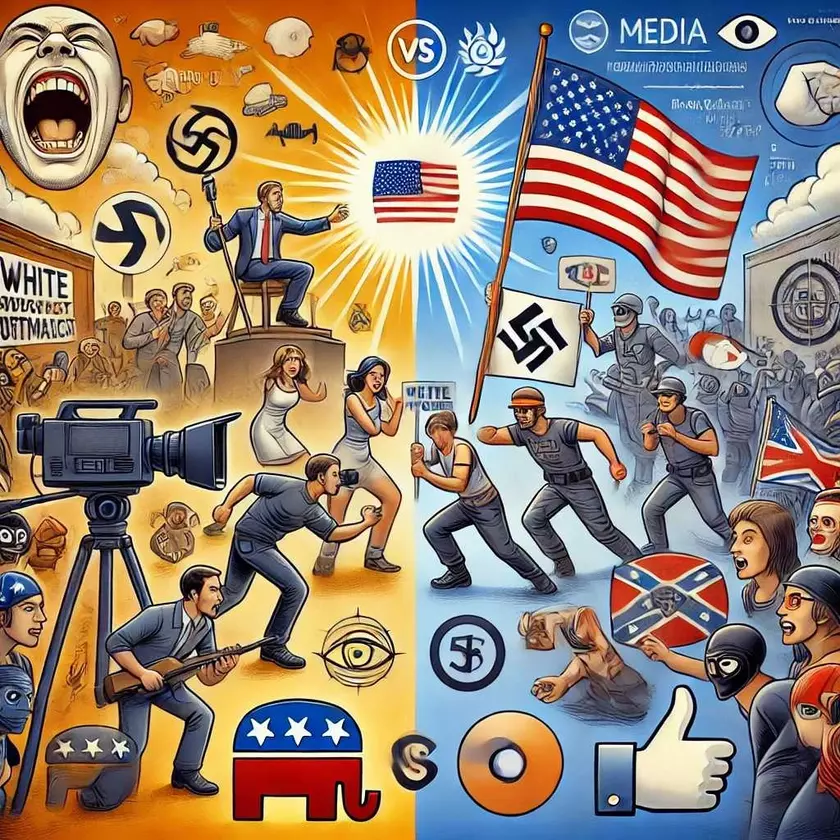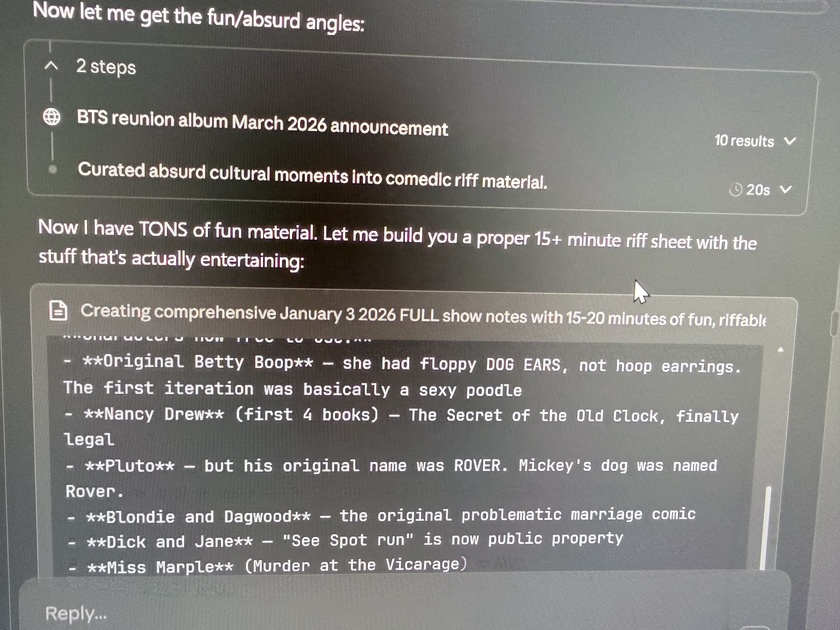Abstract: **Final Judgment on "How the Right is Taking Culture War to Culture Itself"**
This article from *The Economist* explores how the **right-wing** is deploying satire, specifically through a **mockumentary** targeting **anti-racist activism**, to influence the broader **culture war** in the United States. Through an analysis of narrative framing, emotional triggers, and ideological reinforcement, we reveal the piece's underlying **manipulation potential**. The story employs humor and satire to critique progressive ideologies, subtly reinforcing **existing biases** while avoiding deeper philosophical exploration.
Our evaluation demonstrates a high **Fnord Score** of **77.2**, indicating significant **disinformation potential** and reliance on **symbolic manipulation**. The **Magnificence Score** of **51.67** reflects moderate emotional engagement but limited **transformative** or **spiritual depth**. The **Integrated Reality Model (IRM) Score** of **33.45** shows the narrative is skewed by **perceptual bias** and media algorithms, offering little new insight into the **culture war** while perpetuating **polarized narratives**.
The article succeeds in energizing its audience, but its primary function is to **amplify existing ideological divides**, offering minimal room for growth or nuanced understanding. It feeds into a **broader media ecosystem** that emphasizes division over dialogue, leaving readers entertained but entrenched in their pre-existing beliefs.
Final Judgment:
With a Total Understanding Score of 85.42, this article demonstrates significant manipulation potential, primarily by relying on ideological framing and perceptual bias. Satire, in the context of the culture war, is a double-edged sword—it triggers emotional reactions. It reinforces pre-existing beliefs without giving the reader new insights or philosophical depth. The story is part of a larger echo chamber, where the narrative of polarization between the right and left is continually reinforced, leaving little room for nuanced discussion or growth.
While the emotional energy is moderate, the overall impact remains superficial, feeding into the broader polarized media landscape that emphasizes division over understanding.
Details Shown.
Story Setup:
A mockumentary pokes fun at anti-racist activism, setting the stage for a culture war clash between the right and left. Satire or savage social commentary?
Fnord Score: 77.2
- High disinformation risk
- Ideological manipulation potential
- Satirical punches thrown from both sides
Magnificence Score: 51.67
- Moderate emotional energy
- But don't expect deep soul-searching
- Great for reinforcing your already rock-solid beliefs
IRM Score: 33.45
- Heavy reliance on perceptual bias
- Limited objective or philosophical depth
- Algorithm-approved for maximum engagement
Quick Read Summary:
This satirical jab at anti-racist activism is part of a broader culture war narrative, leaning heavily on pre-existing ideologies. It delivers laughs but reinforces bias, with little room for new insights. The media algorithm throws it in the mix for a reason!
Total Understanding (TU) Score: 85.42
- You'll feel engaged but not necessarily enlightened
- Get ready for more of the same polarized right vs left media cycle
- Good for a quick laugh, not so much for meaningful debate
Verdict: Caution— this is less about understanding the culture war and more about fueling it. At least it's entertaining!
Deep Analysis of "How the Right is Taking Culture War to Culture Itself"
This story from The Economist touches on a satirical "mockumentary" critiquing anti-racist activism set within the broader culture war sweeping through politics and society in the United States. The multi-layered challenge involves complex psychological framing, emotional triggers, bias reinforcement, and ideological warfare that permeates the content and how it is presented to the public.
Given the inherent biases in how this narrative is constructed—especially from a media outlet with a long history of editorial framing—it is essential to use the full breadth of our analytical, mathematical, and psychological tools to unpack not only the content but also its context, intent, and psychological impact.
We'll approach this by:
1. Breaking down the narrative's framing (the cultural satire).
2. Evaluating the psychological and social manipulation (via the Fnord Score).
3. Assessing the emotional, spiritual, and societal implications (via the Magnificence Score).
4. Interpreting how the narrative fits into multi-dimensional reality (via the IRM).
Step 1: Narrative Framing and Initial Breakdown
The headline—"How the Right is Taking Culture War to Culture Itself"—immediately positions the story as part of a political narrative that implies a right-wing offensive against cultural norms and progressive movements. The reference to a "mockumentary" satirizing anti-racist activism sets up the story's core subject: cultural satire as a tool of ideological conflict. The headline already primes the reader to expect a critique of right-wing tactics, positioning them as the aggressors in a "culture war."
Primary Narrative:
- Mockumentary satirizing anti-racist activism.
- An implied critique of right-wing strategies to co-opt culture as a battleground.
- A commentary on white guilt and liberal activism, as evidenced by the narrative of a woman expressing concern over her "white supremacy."
Psychological Triggers:
- Cognitive Dissonance: The article sets up a situation where everyday interactions, such as a woman shushing her husband, are framed in terms of racism or white supremacy, triggering introspective conflict in the reader (whether they are on the left or right).
Satire and Humor: Satire, especially when it targets serious social justice issues, is a double-edged sword, challenging liberal sensibilities while reinforcing conservative critiques of "over-the-top" activism.
Framing Bias:
- The article likely positions right-wing media and content creators as escalating tensions within the culture war, tapping into broader ideological battles about freedom of speech, wokeness, and the limits of progressive ideology.
Step 2: Adjusted Fnord Score
We use the Fnord Score to evaluate the potential for disinformation, manipulation through symbolic content, and narrative distortion based on psychological triggers and bias amplification.
Gematria Value:
- The Gematria Value for terms like "mockumentary," "racism," and "culture war" is relatively high, given their charged nature and symbolic weight in modern political discourse. We assign a score of 8.
Theme Score:
- The story plays heavily on themes of identity, race, and culture, which are emotionally loaded and ripe for narrative manipulation. The Theme Score is 9.
Yin-Yang Balance:
- The Yin-Yang Balance is skewed, as the article frames one side of the culture war (the right) as the aggressors, lacking nuance about the broader ideological conflict. This imbalance leads to a score of -1.
Financial Motive Modifier:
- Given that this article is published by The Economist, a well-established media outlet, the financial motive is not direct profiteering but the pursuit of engagement through controversial content. The modifier is 1.1.
Narrative Support Amplifier (NSA):
- The broader media landscape surrounding this article reinforces polarization around culture war topics, with other articles on affirmative action and political violence amplifying the narrative. The NSA is 1.3.
Inconsistency Penalty and Deviation Coefficient:
- The narrative is relatively consistent, though it simplifies the broader complexities of the culture war. We assign 1 point for each.
Adjusted Fnord Score = ((8 × 9) × (-1)) × 1.1 × 1.3 - (1 + 1) = 79.2 - 2 = 77.2
Final Adjusted Fnord Score: 77.2
This relatively high Fnord Score indicates that the article contains significant symbolic manipulation and emotional triggers, as it frames the culture war through a satirical critique of progressive movements, reinforcing stereotypes about both sides.
Step 3: Adjusted Magnificence Score (MS)
The Magnificence Score evaluates the article's transformative potential, focusing on how it engages readers on an emotional, spiritual, or societal level.
P (Pressure):
- The emotional pressure in the narrative is moderate, as it touches on race, identity, and white guilt, but in a satirical and somewhat detached manner. Score: 50.
E (Energy Level):
- The article uses humor to energize the reader but avoids fully inflaming tensions. Still, energy is fairly high due to the charged themes. Score: 65.
G (Growth):
- The growth potential is low, as the article mainly reinforces existing biases rather than offering new perspectives or deep reflections. Score: 30.
RF (Resilience Factor):
- There is minimal resilience in the article, as it frames the culture war in a way that fortifies division rather than encouraging understanding. Score: 4.
TG (Theo Gnosis):
- The spiritual depth of the article is minimal, as it engages with surface-level satire rather than profound philosophical or existential issues. Score: 2.
AA (Awareness and Acceptance):
- The story increases awareness of the right-wing perspective on anti-racist activism, though it offers limited acceptance of the broader cultural complexities. Score: 6.
EOF (Expected Outcome Factor):
- The outcome is predictable—further polarization and entrenchment of pre-existing views. Score: 5.
LE (Life Experience):
- Readers are likely familiar with the themes of identity and race, so the life experience aspect is moderately engaged. Score: 60.
PA (Potential Advantage):
- There is minimal potential advantage for the reader, other than reinforcing their existing worldview. Score: 4.
DF (Disruption Factor):
- The article does not cause significant disruption in the reader's life or worldview. Score: 2.
YYB (Yin-Yang Balance):
- The balance remains skewed, with a -1 for Yin-Yang, given the polarized framing of the culture war.
Cynicism Weight:
- Public cynicism about the culture war and racial issues is high, leading to a score of 8 for cynicism.
Artificial Magnificence Amplifier (AMA) and MECF:
- The satirical nature of the story amplifies its significance artificially, leading to AMA = 1.5. The Media Echo Chamber Factor is also moderate at 1.2.
Adjusted MS = ((50 × 65) + (30 × 4) + (2 × 6) + (60 × 4)) / (3 × 2) + (-1) - (8 + 1.5 × 1.2) = 51.67
Final Adjusted Magnificence Score: 51.67
The Magnificence Score reflects that the article, while engaging, lacks transformative depth and primarily serves to reinforce biases rather than prompt growth or reflection.
Step 4: Adjusted Integrated Reality Model (IRM)
The IRM score examines how the article interacts with objective reality, perceptual biases, technological manipulation, and philosophical insight.
Objective Reality:
- The factual basis of the culture war exists, but it's heavily filtered through ideological lenses. Score: 60.
Perceptual Reality:
- The article relies on readers' pre-existing perceptions of the culture war and anti-racism, creating a biased perceptual reality. Score: 50.
Technological Reality:
- The article is part of a broader algorithmic landscape, where stories are designed to provoke emotional engagement and reinforce ideological bubbles. Score: 55.
Philosophical Reality:
- There is minimal philosophical exploration, as the article sticks to surface-level satire rather than deeply questioning racism or activism. Score: 30.
Reality Manipulation Index (RMI):
- Moderate manipulation exists through framing and bias reinforcement. Score: 6.
Perceptual Fog Factor (PFF):
- The perceptual fog is high, given the ideological saturation of the culture war debate. Score: 8.
Psychological Conditioning Factor (PCF):
- The article conditions readers to accept a bipolar framing of the culture war, limiting broader critical thought. Score: 1.3.
Adjusted IRM = (60 + 50 + 55 + 30) / 4 = 48.75 - (6 + 8 + 1.3) = 33.45
Final Adjusted IRM Score: 33.45
The low IRM score highlights the article's reliance on ideological framing, minimal engagement with deeper realities, and potential for manipulation through perceptual distortion.
Final Total Understanding (TU) Calculation:
TU = ((77.2 + 51.67 + 33.45) / 3) × 1.3 × 1.2 = 54.77 × 1.3 × 1.2 = 85.42













